The final episode of Life in Full Detail is on the way, but we lost a few days of work recently due to some unfortunate excitement that happened our way.
Recently, while walking our American Akita, Hunter, a large unfriendly Rottweiler charged down the street at us and attacked. Everyone is okay but we got very lucky and I wanted to help anyone who ever decides they need to know how to win a fight with a dog.
You will find the story below, along with a guide I put together after doing research for my own education in case it happens again. This was harder than I thought it would be when I started googling while sitting in the emergency waiting room.
I went through a lot of reddit threads, web forums, and random websites with information of mixed quality. This site had a lot of useful information, and I got several of the graphics used in this article there.
I also got some useful information from Leerburg, which trains police and military K9s. Google’s Gemini AI was also very helpful to bounce ideas off of and analyze the strategic considerations I presented to it. At the end of this article, you’ll find a handy tactical summary.
Fortunately, giant Akita that he is, Hunter held his own. Not all dogs will defend themselves or their owners, but most Akita will. It is considered a breed trait. Even Akita, though, look to their owners for leadership and protection.
In general, I feel relatively prepared for human shaped threats, but I had never really prepared to defend myself against one of my neighbors pets. You can spar with a person; you can’t really spar with a dog. I was also unarmed.
I love dogs, and I would hate to have to kill a dog, but I would hate it a lot more if a dog killed me, my dog, or someone I love. Although this advice is given through the tale of one very specific story, the advice is practical for any run in with a dog, or dogs, intent on doing harm.
First and foremost, DO NOT RUN. Dogs can run a lot faster than you, and running away can trigger their prey drive. It can also embolden them in their efforts to keep you out of their territory, depending on why they’ve chosen to attack you.
In this case, some neighborhood kids had let the dog who attacked us out of his yard trying to get minibikes from their Uncle’s house.
No one, not even the adult who was present, was in any rush to secure him and put him back where he belonged. They also weren’t in any rush to help. As I fought a Rottweiler in the street, the people who knew the dog and were related to the owner told me they were too afraid of being bitten to intervene.
Don’t Assume Anyone Will Help You
I yelled at them to grab the dog before he even started towards us, but of course no one did. I have been around dogs all my life, and as he charged down the street towards us, I knew exactly what was coming. I have never been more sure of what a dogs body language was signaling in my life.
Standing your ground will have no impact, but depending on the situation, you may be able to intimidate a charging dog by walking towards it to meet it. You can also yell and do what you can to make yourself look as big as possible.
That wasn’t an option here, so I tried to pull Hunter in circles away from the Rott, keeping myself between them, kicking at his chest and sides to create distance and keep him at bay.
“Grab your fucking dog,” I yelled.
Instead, the people responsible moseyed on down the street towards the fray, taking their sweet time. When the Rott eventually managed to land a bite, he grabbed the side of Hunter’s face with his teeth and began to shake his head violently from side to side.
I felt a swell of fear and panic at the sight of my dog being attacked. It’s important to understand that you will experience feelings like this; be prepared to manage them. They can easily paralyze you if you aren’t. We often hear of “fight or flight” but this response is better described as “fight, flight or freeze.”
Afterwards, several people suggested that I should have just let Hunter “handle it.” I was not about to let some loose Rottweiler hurt my best friend. Akita are tough, but they’re not impervious to harm.
Besides, what’s the point in even being a great ape if you can’t teach some mutt a lesson about respect? There’s a reason even large carnivores become cautious and reclusive if they hear human activity.
Man is the true king of the jungle, for he has the power to destroy it. - Rudyard Kipling, The Jungle Book
I dropped in on top of them, Hunter beneath my legs and behind me with my arms around the Rott’s neck in what I can only describe as a front naked choke, determined to get that mangy cur off of my boy.
The pin-and-choke was ineffective, so I did what any other totally sane person would do: shoved my hands in the Rottweilers mouth and pulled his jaws apart like a madman.
This went surprisingly well, at first. I got Hunter loose, and only had one tooth go through my hand, as you can see in the picture below.
The doctor who treated me was shocked that I had been successful at this. He was also shocked that my injuries weren’t worse; as I said at the beginning, we got very lucky. Which brings us to a rule I’ve come up with for engaging a dog in combat:
Don’t Wrestle with a Dog
This was my first mistake, although I wouldn’t fully realize the risk I took until after the conflict was over and the adrenaline wore off. A Rottweiler has a bite force rated around 300 pounds per square inch (PSI), roughly equivalent to a leopard. An average human throwing a straight punch generates between 75-150 PSI.
A lot of people recommend you offer up your non-dominant arm as a sacrificial limb to the dog. In my opinion, this is advised only as a last resort. The risks are big, even if you wrap your arm with a shirt or belt in an attempt to minimize the damage.
If you don’t have a weapon when you get attacked, you’re going to have to try to use your body to defend yourself or your loved one. In this scenario, the probability that you are going to take some bites is about 100%.
After I pried his mouth off my own dogs face, the Rottweiler pulled back a few steps, looked at me, and then lunged straight at me. Since I had decided to go the ground, I was on my hands and knees and we were face to face.
Instinctively, I dropped my chin to protect my neck and threw my arm up to protect my face. The dog bit my wrist and shook the same way it had done to Hunter’s face. You see them do this with toys a lot; it’s an instinctual move to rend flesh.
Fortunately, I was wearing a watch with a stainless steel band that worked like armor, offering my wrist some protection and making the actual bite I received much smaller than it might have been.
That’s what the indented line before the wound is from; the band of my watch, crushed against my wrist by the dog. You can see how close the wound was to my Ulnar artery as well as the flexor muscle that allows me to move my wrist and hand.
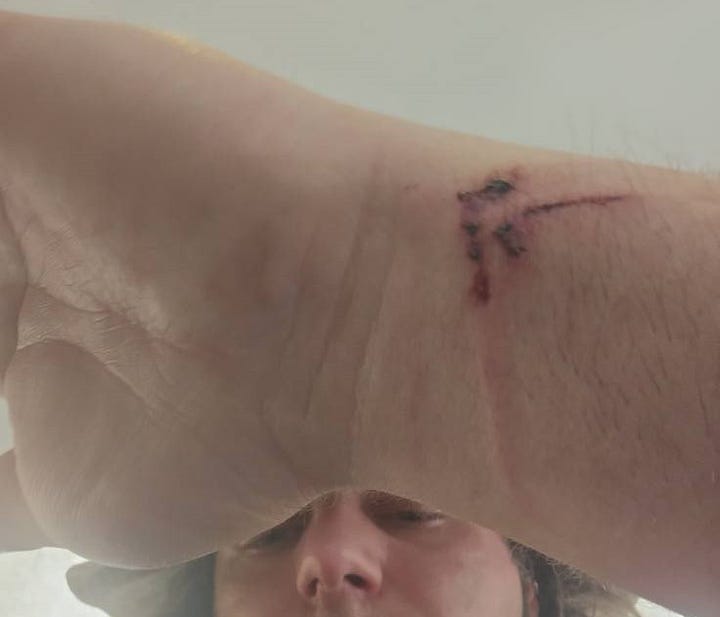
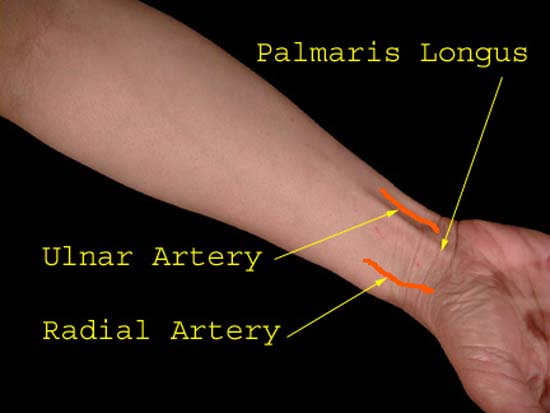
My watch was only about a week old. I bought it to replace an older, identical watch that is no longer wearable. Lucky timing! You can see a scratch along with a small chunk of steel missing from one of the links that the dogs tooth took with it trying to find flesh.
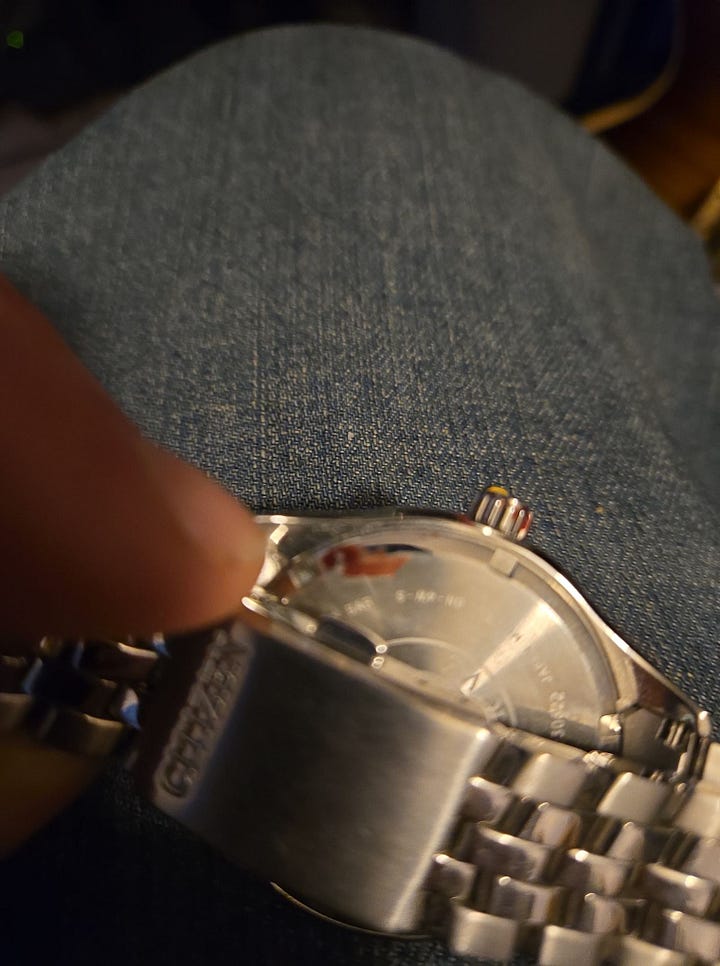
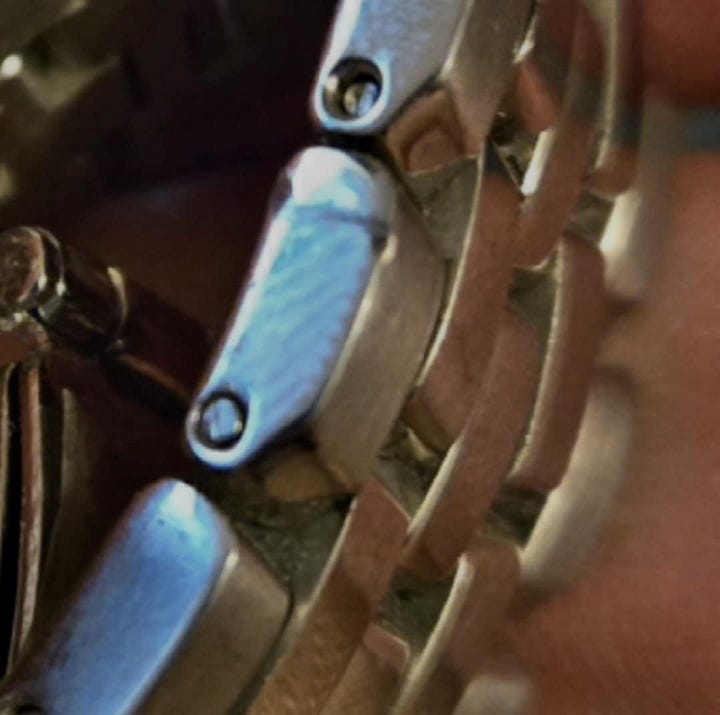


Thank you, Citizen! If you are bitten and suspect that the dog has hit an artery, do what you can to apply pressure. A belt or even a shirt can function as a makeshift tourniquet.
Despite the protection from the bracelet on my watch, this hurt all the same; the dogs teeth sank into the side of my wrist, and his shaking side to side made it feel like my flesh was being torn from my arm.
I didn’t care for that, and as soon as the Rott released my wrist, I balled up my fist and delivered a driving hammerfist to his snout as hard as I could.
The good news here is that there are a lot of ways that fighting a dog is just like fighting a person. If you’ve ever been punched in the face, you likely know exactly how sensitive your nose is. This is because of nerves and soft tissue. Humans have about 5 million nerves in their nose; dogs have 300 million. The nasal bones in dogs are relatively fragile as well.
Studies suggest that tolerance levels for minimal fractures to the snout are in the 25 to 75 lbs range, while the maxilla (the upper jaw itself) has a relatively low tolerance level for fractures as well, in the range of 140-445 lbs. The tolerance of the mandible, the lower jaw, are thought to be lower.
These are well within the force a human can generate with only their fist. As we mentioned above, the average human throwing a punch generates about 75-150 PSI, and a hammerfist can generate up to 4x as much force as a straight punch.
When in Doubt, Strike the Snout
You want to aim just in front of the infraorbital nerve, hitting the nasal surface a little less than halfway up the snout, south of the Crista galli and north of the ethmoidal crest.




As you can see more clearly in the image below, a lot of different bones meet in this area, and a lot of these bones are relatively thin, making the snout structurally weak. The lower jaw is also weak, and a dog with a broken jaw can’t bite you, but be careful not to put yourself in a position to be bit.
The area I pointed out as your target is where the nasal bone meets the maxilla. The skull is relatively thick, and you stand a much better chance of inflicting damage if you target this weak area of the snout.
In humans, damage to this area causes numbness and pain in the lower lateral surface of the nose, the entire cheek, and upper lip, radiating into the jaw and orbital area surrounding the eyes. It doesn’t feel very good, and the experience is much the same for a dog.
The Rottweiler didn’t like it either, and proceeded to dance around me to bite my other arm at the bicep. In the images below, you can see from the delayed bruising how much force was involved in this. The first picture is from just afterwards; the second picture is from several days later.

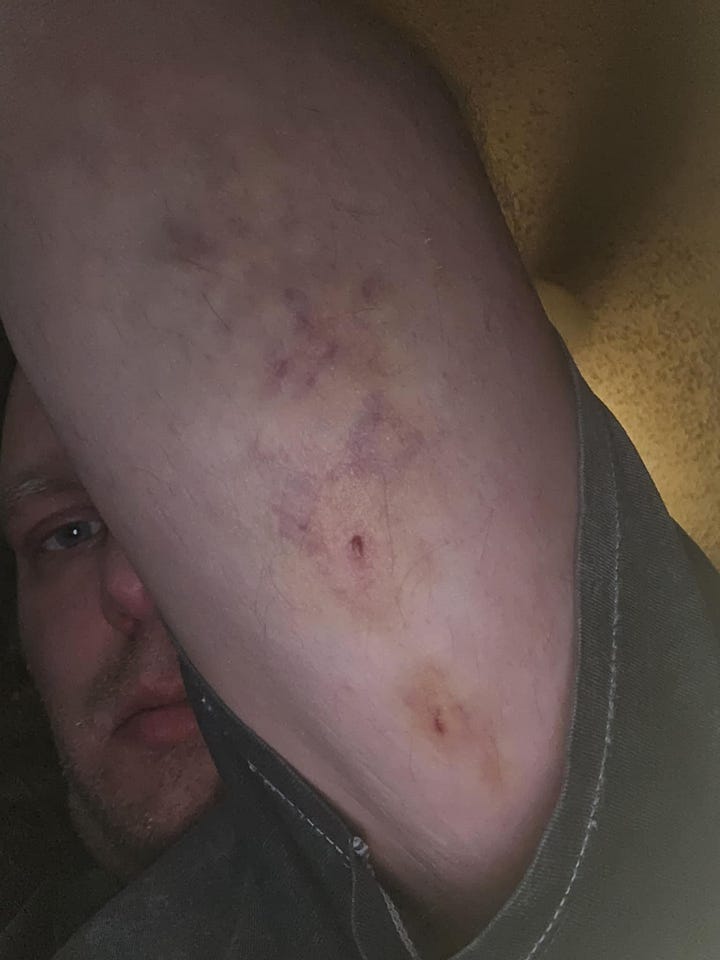


Don’t Assume the Dog Will Stop
While the good news is that there are a lot of ways that this is just like fighting a person, the bad news is that a dog is still a formidable threat. I would describe it as being like fighting a crazy person with a mouth full of knives.
Bites to the bicep are even more dangerous than bites to the forearm. The brachial artery is located in the back of the bicep, and it’s a lot thicker and harder to tie off than the ulnar and radial arteries in the wrist.
Damage to the brachial artery can result in rapid and significant blood loss because of its size and location, and a severe injury to the brachial artery can easily be life-threatening.
It takes less than 3 minutes to bleed out from a severed brachial artery, and if it doesn’t kill you, it can also lead to other serious medical complications, including total loss of the arm from limb ischemia (lack of blood flow).
Stay Upright
If it attacks you directly, a dog will likely try to bring you to the ground. Avoid this at all costs. There are three ways a dog can get you on the ground; four if you include deciding for yourself to put it in a choke hold.
It can jump at your chest to knock you down. This is one of the most common ways that dogs attack people, and with bigger dogs this often leads to facial bites as well. It can and likely will bite at your limbs, rendering them useless and pulling you to the ground.
This is a very natural movement for dogs, and it’s why police and military K9s are trained this way. It can also physically bowl into you and knock you over, so try to be nimble and not let it run right into you.






Despite how scary and formidable a dog might be, humans are much more robust than dogs. We are stronger, much smarter, and better equipped for this kind of combat. While your limbs are vulnerable to their teeth, their limbs are VERY vulnerable to lateral force applied by strikes from your limbs.
If you can get ahold of both legs- front or back, as a pair - you can pull them apart like they were a wishbone. If you do this to the forelimbs, jerking them straight out to the sides as hard as you can, you can easily break or dislocate the legs, effectively immobilizing the dog. If you’re strong enough, you might even crack the rib cage, which reddit suggests could cause the dog to go into cardiac arrest.
If you do this to the rear legs, you can destroy the dogs stability, possibly even dislocating the hip joints or breaking the legs, destroying its attack platform entirely and immobilizing the dog.
Be wary, though - if the dog is smart (or just gets lucky) it may turn or alligator roll to try and bite you. They also have four paws full of blunted claws. These aren’t as dangerous as the teeth, but they can still cut you!
They’re very nimble and quick, although the humans best weapon - our brain - may allow you to predict what how the dog will respond.
An alternative strategy would be to try targeting the same general area - in this case, the lower leg joint - with hard low kicks and stomps. Let opportunity be your guide.
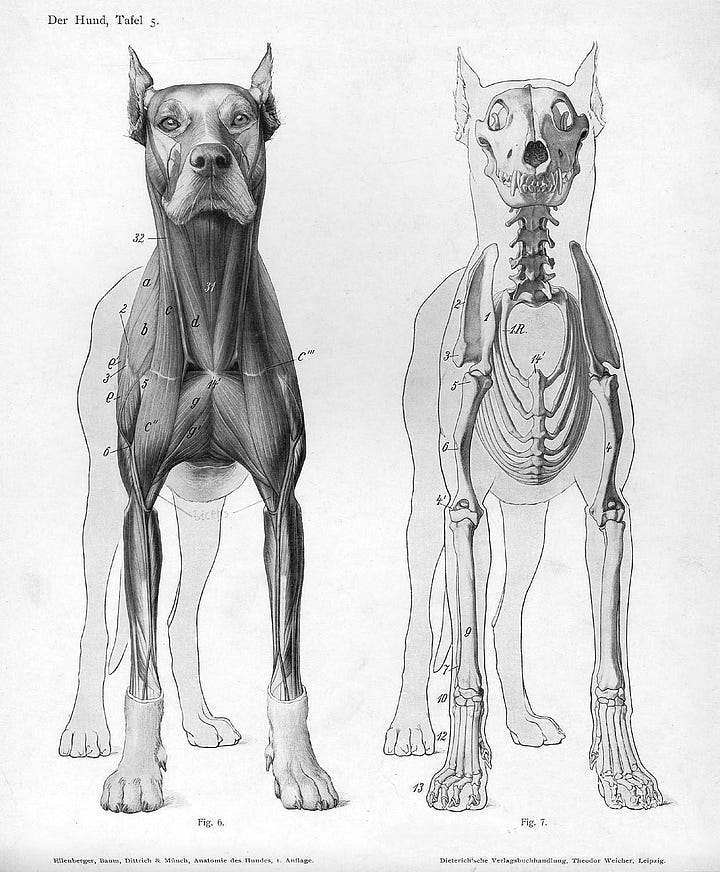
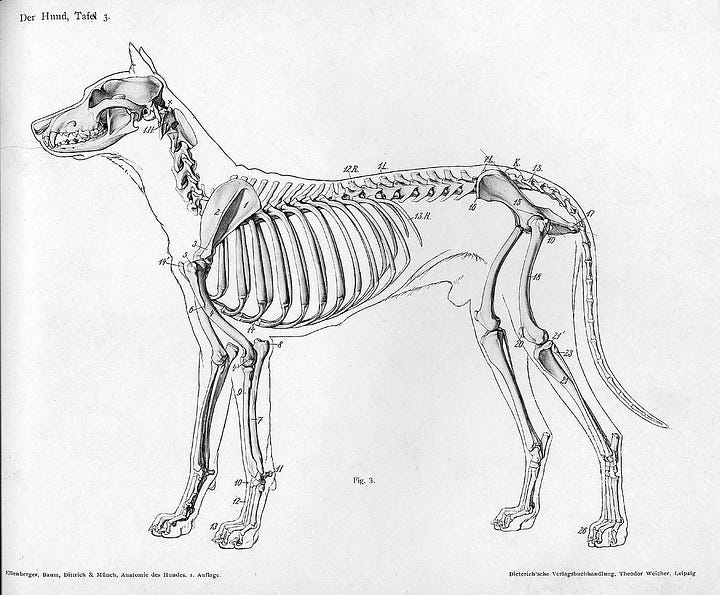
These are relatively low risk, high value targets. If you are attacked alone, it may be challenging to get at the rear legs. If the dog is attacking your dog, or someone else who is with you, it should be relatively easy to circle the dog as you strafe at its lower joints with kicks and stomps.
It may subsequently turn its attention to you, so be prepared for that. I got very, very lucky; the bite to my bicep was not as bad as it could have been, likely because Hunter defended me by taking the opportunity to counterattack.
Hunter did not bite and shake. Hunter bit and released, bit and released, bit and released, over and over and over again. This is an interesting strategic difference that we will consider below, as it also applies to our weapons strategy.
Hunters counterattack made the dog release me before he even got both sets of canines into me (2 wounds, not 4) and before he had the chance to shake his head from side to side. I took this opportunity to get back on my feet and regroup.
The Rottweiler targeted Hunters face again as he had before. At this point I began yelling again at the group of people standing around to do something about their dog. The kids assumed I meant the adult, and one of them said, “She doesn’t want to get bit.”
I replied forcefully and rudely that I didn’t fucking care, which worked and spurred her into action: as I grabbed Hunter’s collar and bashed the Rottweiler repeatedly in the face, she grabbed the Rott by the tail and started pulling until they were separated.
By this time we had drifted from the road to a fenced open field, albeit one with an open gate, and she managed to get the dog on the other side of the fence. I shifted to the left in the hopes that the dog wouldn’t realize the gate was still wide open and we were mere steps away.
This seemed to work. The Rott was still snarling and growling through the fence but did not attempt to come back through the open gate. Hunter was calm as can be, and looked up and back at me, as if to ask, “Wtf is this dogs problem?”
I quickly realized I was injured, and called Viktoria to tell her what happened and ask her to come meet me with our van so that Hunter and I could rest on the way home.
Poor Hunter barely got 1/4 of his walk, and I was off to the emergency room to lick my wounds. I began to research this article sitting in the waiting room.
Know Your Enemy
In the aftermath, I realized that I needed to be better prepared in case this ever happened again, and began trying to research how to engage a dog in combat.
At the time of the incident, my mindset was just to separate them.
That mindset was the result of operating under the (false) presumption that the responsible parties would act like responsible parties.
In the event that something like this happens again, my mindset will be very different.
In a life-threatening situation where a dog is actively attacking you or a loved one, self-preservation is the absolute priority. You can not rely on other human beings to step in, even if they own the dog, and you can not rely on causing the dog enough pain to make it stop.
Dogs experience pain differently than we do, and have a much higher pain threshold than the average human. In a drive state, like prey drive or guard drive, they ignore or suppress pain signals. You will probably not be able to stop a dog attack by causing pain the way you often can with a person.
Fighting a dog is going to be like fighting someone who is drunk or hopped up on PCP. They won’t listen to reason and are unlikely to talk themselves down.
Again; immobilize, incapacitate, and destroy are the only viable options to ensure your own safety. They do make pepper spray for dogs - which is like bear spray - but it isn’t always effective.
In a high enough drive state, the dog may ignore the capsaicin spray completely. There are numerous reliable reports of this happening. Trying to choke a dog isn’t always effective, either, and is a risky proposition.
It’s easy to choke out a person; if you effectively cut off the blood supply to a human brain, they’re going out quick - like, 15 seconds.
Due to a variety of factors, if you choke a dog, you are most likely to perform an airway choke. This will take about 2 minutes in the best case scenario.
If you do manage to knock it out that fast and you let go, the dog will wake back up pretty quickly and most likely attack you again. Dogs that go unconscious in a drive state usually come to in a drive state. It may take as long as 6 minutes to choke a dog to death.
If the dog is wearing a collar, or if you’re able to get something around its neck (your belt, a shirt, whatever) you can choke it to get it to let go of something it’s attacking. The method with a collar is to grab the back of the collar with both hands and pull straight up, towards the sky.
This can be a helpful tool if they’re attacking someone you love; it will let go of whatever it’s biting but it’s not a good solution for ending the fight. Also, be wary of the dog twisting around to bite you.
Even with a collar, this is still possible. It is somewhat less likely with a belt, assuming you can get your belt fastened around its neck. The further your hands are from the scruff of the neck, the less likely they can reach you with their teeth.
Carry a Weapon
I often conceal carry a firearm but I wasn’t carrying on this walk around my neighborhood in broad daylight with my 130 pound American Akita.
Even if I had been, I was surrounded by homes, busy roads, and children. That isn’t a great environment to discharge a firearm safely. Between the kids and the dogs jumping around, spinning, and biting each other, there’s a good chance I wouldn’t have been able to get off a clean shot anyway.
When I talked to some people in my circle about this immediately afterwards, a lot of them suggested I should carry a bat, for some reason.
I am not sure why this was a popular suggestion and I don’t want to carry around a baseball bat every time I walk my dog. I’ll get into some of the combative aspects of this below but suffice to say, a knife is a better bet than a club.
I used to always carry a knife but got out of the habit. After my experience with this dog attack, I will always carry a knife, forever.
Some knives are better than others for the purpose of potential combat with a vicious dog and some knives are more practical than others for carrying.
A folding blade is more likely to break. A fixed blade with a full tang construction, where the blade extends through the entire handle, is highly recommended for strength and durability in this application.
As long as it’s legal to carry wherever you are, you’re going to want a fixed blade that’s 4-6” long. This gives you good reach to maintain some distance while also ensuring good penetration and maintaining maneuverability - a longer blade is more cumbersome and more likely to get stuck.
Serrated edges are more likely to snag and tear, more likely to get stuck, and more difficult to remove if stuck. A straight edge is generally preferred for rapid controlled strikes and clean slices. This minimizes the risk of the blade getting tangled in fur, muscle, or even bone.
Avoid smooth or slippery handles; a good handle is essential for maintaining a secure grip in a high-stress and potentially wet situation.
Knife blades come in a wide variety of styles which have various pros and cons. A clip point or drop point blade will offer a good balance of piercing and slashing capabilities. A spear point is primarily good for piercing with poor slashing or slicing capabilities.
Tanto points are designed for piercing thrusts, making them very good at penetrating thick materials. The tanto design also makes them very strong and less likely to break at the tip compared to other styles.
This could be useful for targeting vulnerable areas covered in thick fur but may not be as efficient for slashing as a blade with a belly.
Knives also come in a variety of metals that all have some kind of trade off. A CPM (Crucible Particle Metallurgy) blade will hold up the best but will also cost the most. Any blade is better than no blade.
This seems like a good time to compare a blunt object like a baseball bat to a blade. A club, such as a baseball bat, presents a very different set of tactical considerations compared to a knife.
While a club is a powerful tool, it has significant limitations. The biggest limitation with a knife is that you need to be mindful of where you’re stabbing to avoid “friendly fire.”
The biggest benefits of a club over a knife are that a bat is much more forgiving, requiring less precision to use effectively. It provides significantly greater reach, functioning almost as a barrier, allowing you to maintain distance and minimize the risk of being bitten.
This is especially true if faced with multiple hostile dogs. A bat can also deliver tremendous blunt force trauma - a typical bat when used to hit a ball can exert as much as 8,000 PSI. This is more than enough power to disable a dog… assuming you don’t miss, which you might.
A bat requires a wide swing to generate large amounts of force, making it much slower than a knife strike. If you miss and overcommit, it can throw you off balance, leaving you vulnerable to attacks.
A bat can be cumbersome and difficult to maneuver in close combat. A bat is also not easily concealed or carried with you, and may not be readily available in an emergency. I have a knife with a 4” blade in my pocket as I sit typing this. As long as it’s in my pocket, it’s always with me.
Of course, the best choice depends on the specific circumstances of the encounter. If you happen to have a bat handy, by all means, use it. A bat offers superior reach and impact force, where a knife offers superior speed and access.
Given the potential for unexpected close combat and the need for rapid response, a knife offers much greater overall versatility than a bat.
Tactical Advice:
To recap:
Don’t Assume Anyone Will Help You
Assume You Will Be Bitten
Don’t Wrestle with a Dog; Stay Upright
Don’t Assume the Dog Will Stop
Carry a Weapon
The limbs and joints are high value targets for low kicks and stomps. These are high priority targets. If you the dog can’t move itself, it can’t bite you.
The snout is a high value target for kicks and strikes as well. If you break the snout or the lower jaw, the dog won’t be biting you either.
Attempting to choke the dog will be difficult and carries high risks
For a blade, the limbs are also a high value target, but aim for the upper joints instead of the lower ones, marked D in the graphic on the left below, and you can see why in the image on the right. There are arteries, and bleeding the dog out is your best bet to sap its will to fight.
Likewise, the area just below the jaw and the neck are high value targets. The airway is another high value target, marked B in the image below, and you can see it’s high up in the neck, whereas the arteries are slightly lower. Be wary of the teeth.


C is a major artery cluster located to either side of the canine spine just about even with the leading edge of the rear leg. Puncturing or severing any of these arteries will result in rapid incapacitation of the animal. This target may be harder to get to, depending on the exact nature of your conflict.
Point E is the diaphragm and intestinal cavity of the dog; this is a high value, high risk target, and one you should approach opportunistically as a secondary target. Do not put yourself in harms way attempting to reach the underside of the dog.
A thrust into this area (just below the rib cage back towards the rear legs) will likely damage vital organs, and possibly sever several arteries and major veins. A deep enough slash may even disembowel it completely.
Point F is the large muscle groups and tendons on the front of the hind legs. This is also a high value target you should approach opportunistically; powerful slashes to these areas can immobilize the dog, as well as potentially severing major veins, but they may be difficult to reach depending on the nature of the conflict.
Point G are tendons and large muscle groups on the rear of the hind legs. This is also target of opportunity. Successfully delivered powerful slashes or thrusts pulled out to the rear can immobilize the dog, as well as potentially severing major veins.
The eyes are another target of opportunity for both thrusts and slashes. They are small and difficult to hit, and should therefor be considered a secondary target, but dogs use their eyes for target acquisition and, if you damage the eyes, the dog may disengage entirely.
Combative Tactics Summary:
Footwork and Movement: Use evasive maneuvers and maintain balance to avoid being cornered or put on the ground.
Lateral Stomps & Low Kicks: Deliver powerful lateral stomps and low kicks to the dog's rear hocks to break or dislocate leg joints and disable mobility.
Standing Rear Mount: If possible, establish a standing rear mount for control and access to vulnerable areas.
Control Hips: Use your legs and body weight to control the dog's hips and prevent it from turning.
Target Vulnerable Areas:
Eyes
Nose
Throat
Leg & Joints
Arteries
Prioritize strikes to the limbs (tendons, joints), neck (arteries, airway), and upper shoulders (major arteries). If the belly is exposed, it is also a very high value target.
Strike Technique: As I mentioned above, dogs have two primary strategies for biting, and these apply to knife strikes as well. One method is to stab and jerk; another is rapid, repeated strikes. Multiple rapid strikes with a straight blade will maximize blood loss, which is your best chance of making the dog disengage, and minimize the risk of blade entanglement. Strike at different angles to maximize damage.
Defensive technique: Use the weapon to parry, redirecting incoming attacks into counterstrikes.
Maintain Distance: Utilize the weapon's reach to keep the dog at bay and control the engagement.
Adaptability: Be prepared to transition between different tactics based on the dog's behavior and the situation.
Predictability: If the dog exhibits predictable attack patterns, exploit them.
Vulnerable Canine Areas:
Eyes
Nose
Throat
Leg & Joints
Arteries


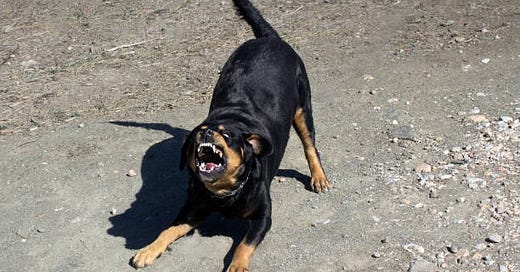










This is absolutely terrifying. Dogs can cause tremendous injuries and disfigurement. I have a morbid fear of dogs and panic whenever I see one running loose in my neighborhood. My first job was working as a veterinarian technician and I remember this couple bringing in their unneutered, untrained massive rottweiler. He was so powerful and aggressive the veterinarian told the couple- that were "too cool" to remove their dogs nuts and thought their dog was a "badass" to intimidate people with- to not EVER bring that dog back into her clinic to endanger her staff or other clients. Dogs like rottweilers, that are capable of doing great harm, need to be cared for by only the most responsible, serious pet owners. I also knew a massive rottweiler named Elvis that was a 200 pound sweetheart-but his owner, my grandmother, took the utmost responsible behavior with him so the scenario that happened to you would never happen to anyone. I have chills reading this, you really did survive a horrifying experience. But this is also a great reminder to be aware not only of people, but the dangers of animals when out walking. I am fascinated by the information you gave about using a bat as a weapon. My grandfather was a police officer and advised me to keep a metal baseball bat near me at home for protection (from invaders). Well, I hope you recover from this and thank you for sharing this information.
Thanks for the info, I hope I’ll never need it! It’s almost impossible to know how different people will react in situations like that, and noone can really know about themselves before they’ve been there. Awesome that you didn’t freeze, and may I just add, totally badass!